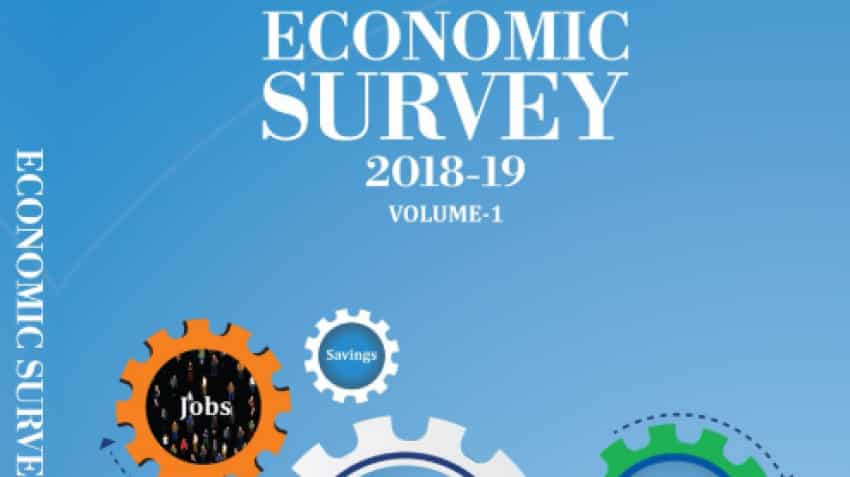Economic Survey 2018-19: India’s foreign exchange reserves continue to be comfortable
Economic Survey 2018-19: India’s external debt was USD 521.1 billion at end-December 2018, 1.6 per cent billion lower than its level at end-March 2018.

The Economic Survey 2018-19 tabled today in Parliament by Union Finance Minister Nirmala Sitharaman has stated that India’s foreign exchange reserves continue to be comfortable, according to the government statement, adding that India’s foreign exchange reserves continue to be comfortably placed in excess of USD 400 billion.
According to the Survey, the Rupee traded in the range of 65-68 per USD in 2017-18 but depreciated to 70-74 in 2018-19. The exchange rate in 2018-19 has been more volatile than in the previous year, mainly due to volatility in crude prices, but not much due to net portfolio flows. The Real Effective Exchange Rate also depreciated in 2018-19, making India’s exports potentially more competitive. The income terms of trade, a metric that measures the purchasing power to import, has been on a rising trend, possibly because the growth of crude prices has still not exceeded the growth of India’s export prices.
Other key highlights of the survey are:
1. India’s external debt was USD 521.1 billion at end-December 2018, 1.6 per cent billion lower than its level at end-March 2018. The long-term debt declined by 2.4 per cent to USD 417.3 billion at end-December 2018 over end-March 2018, though its share was mostly same at 80.1 per cent of total external debt compared to 80.7 per cent during the same period.
2. The composition of India’s exports and import basket has by and large remained unchanged in 2018-19 over 2017-18. India’s merchandise exports stood at USD 330.07 billion in the year 2018-19.
3. Petroleum products, precious stones, drug formulations, gold and other precious metals continue to be top export items. India’s import was USD 514.03 billion during the year 2018-19 and crude petroleum, pearl, precious, semi-precious stones and gold remained as top import items. The trade deficit was USD183.96 billion during the period. India’s main trading partners continue to be the US, China, Hong Kong, the UAE and Saudi Arabia.
4. On India’s External Sector, the survey states that it continues to be stable. Although the Current Account Deficit (CAD) increased to 2.1 per cent of GDP in 2018-19, up from 1.8 per cent in 2017-18, it is within manageable levels. The widening of the CAD has been driven by a deterioration in the trade deficit from 6.0 per cent of GDP in 2017-18 to 6.7 per cent in 2018-19. Rise in crude oil prices in 2018-19 led to the deterioration of trade deficit.
5. Acceleration in the growth of remittances has, however, prevented a larger deterioration of CAD. In funding the CAD, the total liabilities-to-GDP ratio, inclusive of both debt and non-debt components, has declined from 43 per cent in 2015 to about 38 per cent at end of 2018.
6. Further the share of foreign direct investment has risen and that of net portfolio investment fallen in total liabilities, thereby reflecting a transition to more stable sources of funding CAD. In sum, although CAD to GDP ratio has increased in 2018-19, the external indebtedness continues to be on a declining path.
#BudgetWithZEE | जानें #Budget के दिन कैसी रहेगी बाजार की चाल, BULLvsBEAR में कौन रहेगा हावी?@sandeepgrover09 #Budget2019 pic.twitter.com/x4eXCM4eLC
— Zee Business (@ZeeBusiness) July 4, 2019
7. India ratified the WTO Agreement on Trade Facilitation (TFA) in April 2016 and subsequently constituted a National Committee on Trade Facilitation (NCTF) which has played an important role in reducing the high cost of imports and exports so as to integrate our cross-border trade with the global value chain.
8. These efforts have resulted in substantive improvement of India’s performance in ‘Trading Across Borders’ indicator as well as in ‘Ease of Doing Business’ ranking. The logistics industry of India has also seen significant development which has led to a jump in India’s global ranking in the World Bank's 2016 Logistics Performance Index.
9. A draft National Logistics policy has been announced by Government of India, for which a national logistics action plan is being developed. The key objective is to drive economic growth and trade competitiveness of the country through a truly integrated, seamless, efficient, reliable and cost effective network through various logistics schemes.
Get Latest Business News, Stock Market Updates and Videos; Check your tax outgo through Income Tax Calculator and save money through our Personal Finance coverage. Check Business Breaking News Live on Zee Business Twitter and Facebook. Subscribe on YouTube.
RECOMMENDED STORIES

Power of Compounding: How long it will take to build Rs 5 crore corpus with Rs 5,000, Rs 10,000 and Rs 15,000 monthly investments?

Looking for short term investment ideas? Analysts suggest buying these 2 stocks for potential gain; check targets

Small SIP, Big Impact: Rs 1,111 monthly SIP for 40 years, Rs 11,111 for 20 years or Rs 22,222 for 10 years, which do you think works best?

Rs 3,500 Monthly SIP for 35 years vs Rs 35,000 Monthly SIP for 16 Years: Which can give you higher corpus in long term? See calculations
05:11 PM IST










 GDP growth rate will be even better: EaseMyTrip co-founder Rikant Pitti on Economic Survey projections
GDP growth rate will be even better: EaseMyTrip co-founder Rikant Pitti on Economic Survey projections India's renewable energy sector to attract investments worth Rs 30.5 lakh crore by 2030: Economic Survey
India's renewable energy sector to attract investments worth Rs 30.5 lakh crore by 2030: Economic Survey Economic Survey asks states to expedite implementation of labour codes
Economic Survey asks states to expedite implementation of labour codes Economic Survey caution against sensitive food commodities in futures trading
Economic Survey caution against sensitive food commodities in futures trading